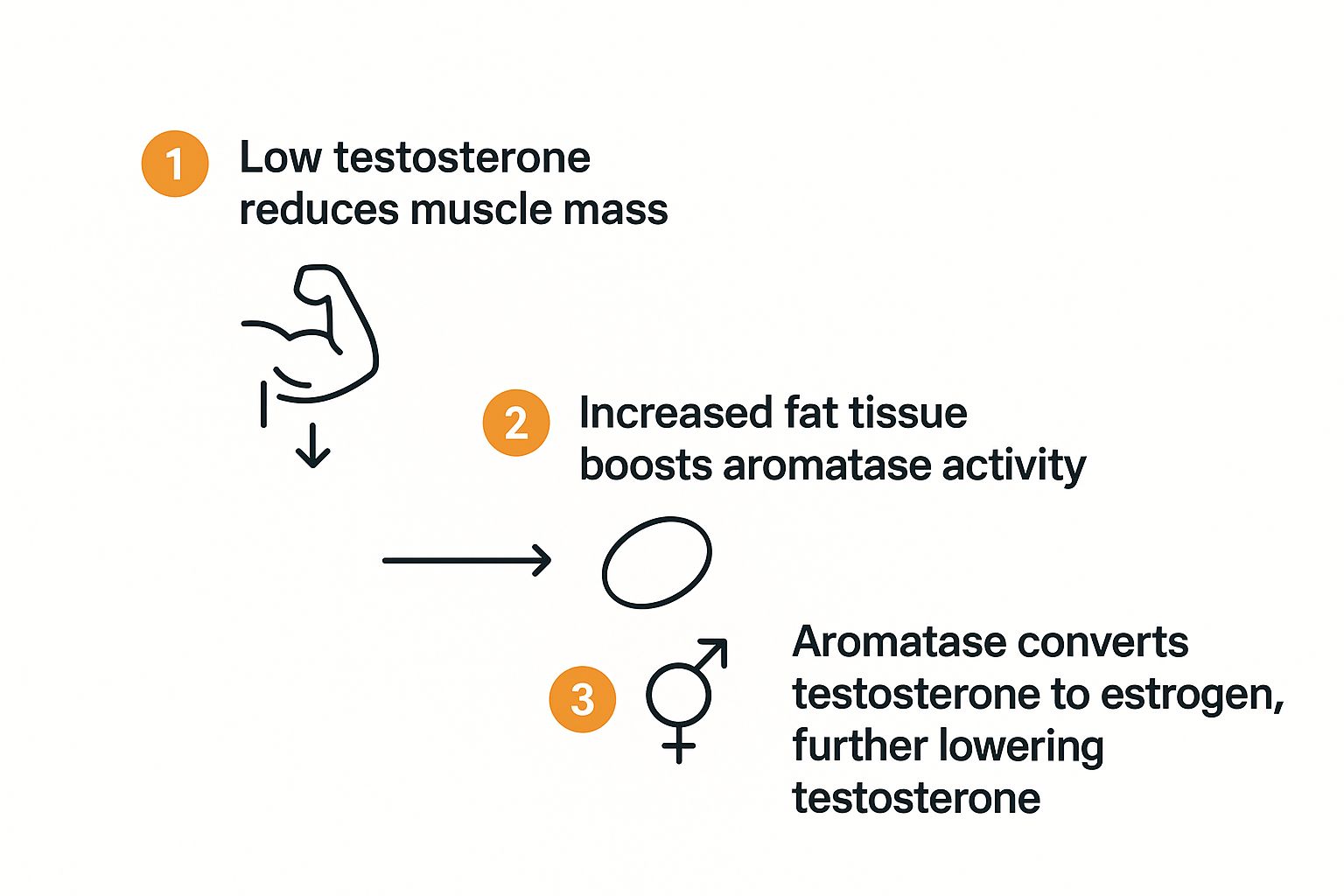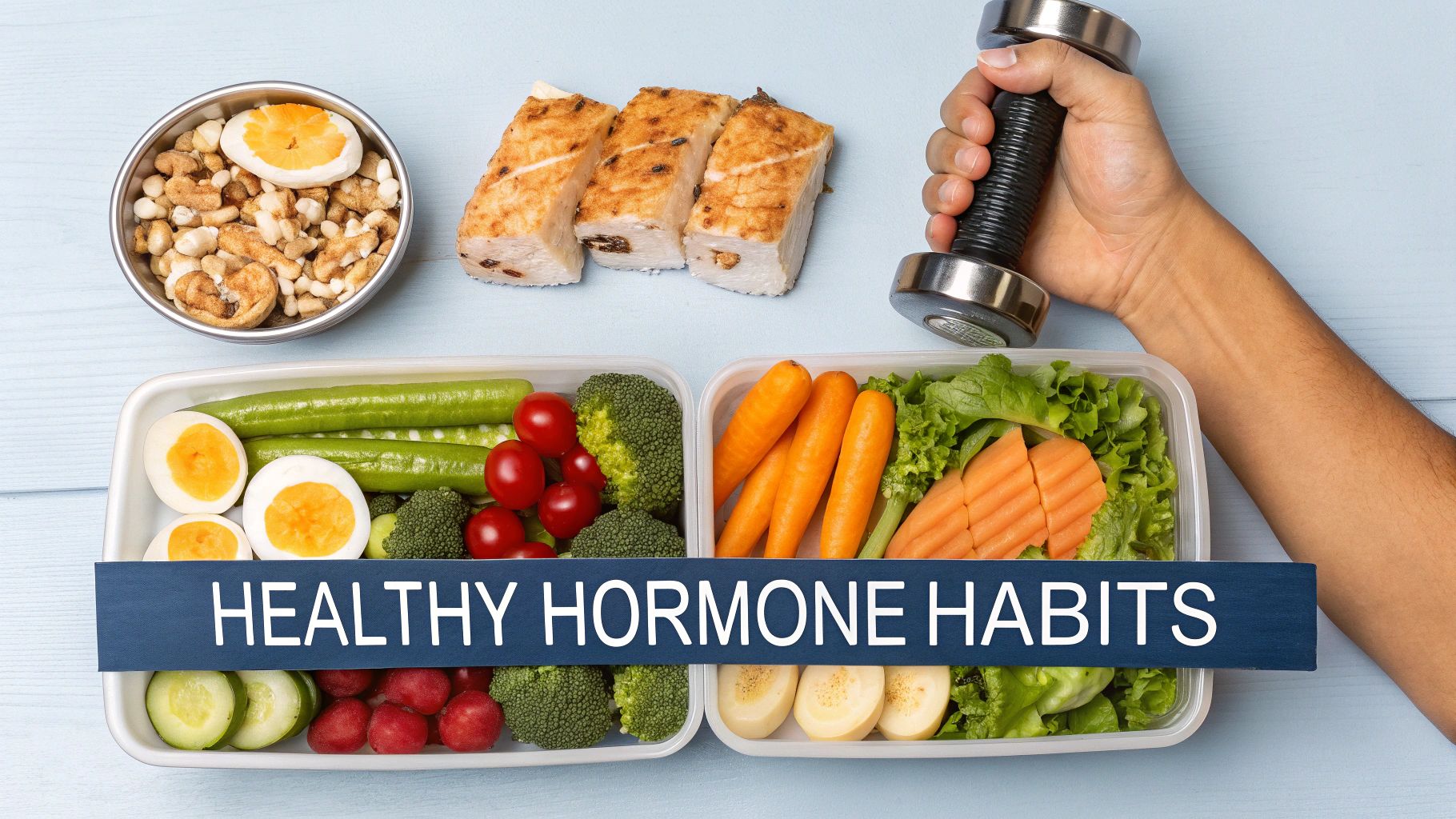Understanding Low Testosterone in Women/Weight Gain: Causes & Solutions

Yes, there is an undeniable connection between low testosterone in women and weight gain. When your testosterone levels dip, the first thing to go is often your hard-earned muscle mass. Because muscle is your body's calorie-burning furnace, losing it slows your metabolism way down.
This creates a frustrating biological trap where your body becomes incredibly efficient at storing fat, particularly around your midsection. It’s a vicious cycle that even the strictest diet and exercise plans often can't break on their own.
The Hidden Link Between Hormones and Weight

It’s a story I hear from women all the time. You’re doing everything right—eating clean, hitting the gym, prioritizing sleep—but the number on the scale just keeps creeping up. A deep, persistent fatigue has settled in, making every workout feel like a monumental effort.
It's so easy to blame yourself, to think you must not be trying hard enough. But what if the real culprit is a hormonal imbalance you haven't even thought to check?
The frustrating reality for many women is that this unexplained weight gain is tied to a hormone that's often overlooked in women's health: testosterone. While it's typically seen as a "male" hormone, testosterone is absolutely essential for women. It’s a key player in maintaining energy, building lean muscle, and keeping body fat in check.
When those levels fall, it kicks off a chain reaction of changes that can make managing your weight feel completely impossible. This isn't about a lack of willpower; it’s about your body's fundamental biology working against you.
Why Low Testosterone Drives Weight Gain
Understanding why the weight is piling on is the first step toward getting back in control. Low testosterone doesn’t just add a few extra pounds; it fundamentally alters how your body uses and stores energy. This hormonal dip is a direct driver of weight gain in a few interconnected ways.
Here’s a look at how this shift messes with your body:
- Vanishing Muscle Mass: Your body depends on testosterone to build and hang onto lean muscle. When levels are low, that muscle tissue starts to shrink—a condition called sarcopenia.
- A Sluggish Metabolism: Think of muscle as your body's engine. Less muscle means your resting metabolic rate slows to a crawl, so you burn fewer calories just existing.
- Stubborn Fat Storage: Low testosterone can actually signal your body to start storing more visceral fat. This is the unhealthy, hard-to-lose fat that wraps around your abdominal organs.
- Zero Energy and Motivation: The bone-deep fatigue that comes with low testosterone makes it incredibly difficult to stay active, creating a self-perpetuating cycle of weight gain.
To give you a clearer picture, this table breaks down the direct impacts of low testosterone on your body composition.
How Low Testosterone Drives Weight Gain in Women
| Physiological Impact | Effect on the Body | How It Leads to Weight Gain |
|---|---|---|
| Muscle Loss (Sarcopenia) | The body loses its ability to maintain lean muscle tissue effectively. | Less muscle means a lower resting metabolic rate, causing you to burn fewer calories. |
| Metabolic Slowdown | Your body's "engine" idles at a much lower speed, conserving energy. | Calories that were once burned for fuel are now more easily stored as fat. |
| Increased Visceral Fat | Hormonal signals encourage the storage of fat around internal organs. | Leads to stubborn belly fat and increases the risk of metabolic diseases. |
| Energy Depletion | Persistent fatigue and low motivation make physical activity feel exhausting. | Reduced activity levels further decrease daily calorie burn, accelerating the cycle. |
This summary highlights how interconnected these factors are. It's not just one thing, but a cascade of biological changes that make weight gain almost inevitable.
It's a huge misconception that testosterone is only for men. In reality, it is a critical hormone for female metabolic health. Keeping it balanced is essential for maintaining a healthy body composition.
This guide will walk you through the science behind this connection, helping you recognize the symptoms, explore effective treatments, and discover lifestyle strategies to finally regain control. You are not alone in this, and there are clear, actionable steps you can take to restore your body’s natural balance.
How Testosterone Keeps Your Metabolism Firing
Think of your body’s hormones as a highly skilled orchestra. Each one, from estrogen to thyroid hormone, plays a critical part in a symphony that keeps you healthy and balanced. In this orchestra, testosterone is the powerful rhythm section, driving the tempo and strength that keeps your metabolism humming. It’s often typecast as a male-only hormone, but it’s absolutely essential for a woman's metabolic health.
Testosterone is the primary architect of your muscle mass. Imagine it’s the foreman on a construction site, constantly directing resources to build and maintain lean muscle. This muscle is your metabolic engine—it burns calories for energy, even when you’re just relaxing on the couch. The more lean muscle you have, the hotter your metabolic furnace burns all day long.
When testosterone levels are where they should be, your body is an efficient calorie-burning machine. You have the energy for workouts, you recover quickly, and your hard work in the gym and kitchen actually pays off. But when this crucial hormone takes a nosedive, the entire system starts to sputter.
The Metabolic Slowdown Effect
A drop in testosterone is like telling that foreman to take an indefinite vacation. Without its direction, muscle maintenance slows down, and building new muscle grinds to a halt. This leads to a gradual loss of that precious, calorie-burning tissue. As a result, your resting metabolic rate—the number of calories your body burns just to keep the lights on—starts to drop.
This is the real reason the old "eat less, move more" advice fails so many women. You could be meticulously counting calories and spending hours on the treadmill, but if your metabolic engine is running at half-speed due to low testosterone, the results will be minimal and incredibly frustrating. Your body is biologically programmed to conserve energy, not burn it.
Low testosterone essentially rewires your body to store fat instead of building muscle. This metabolic shift is a biological reality, not a reflection of your effort or willpower.
This slowdown also hits your energy levels hard. Feeling too wiped out to even think about a workout isn’t just in your head; it’s a physiological response to a hormonal imbalance. Your body simply lacks the drive and cellular energy it needs, making physical activity feel like climbing a mountain and feeding into the cycle of low testosterone in women and weight gain.
The Complicated Dance with Body Fat
The relationship between hormones and weight isn't always a straight line. For example, as global rates of overweight and obesity rise, women's hormone profiles are changing in complex ways. By 2016, around 40% of adult women worldwide were overweight, with another 15% classified as obese.
Interestingly, studies show that overweight women often have higher circulating testosterone levels but lower levels of a protein called sex hormone-binding globulin (SHBG). This protein is like a sponge that soaks up testosterone, making it inactive. When SHBG is low, more "free" testosterone is available to the body. This creates a paradoxical situation that really highlights the delicate balance required for true metabolic health. Discover more insights about these hormonal complexities in women.
How Your Body Shape Changes
With less testosterone to command muscle-building, your body starts to favor fat storage—especially around your abdomen. This isn't just surface-level fat; it's visceral fat, the dangerous type that wraps around your internal organs and is notoriously hard to get rid of.
This process creates several frustrating changes you can see and feel:
- A Softer Physique: You might notice a loss of muscle definition, even if you’re hitting the weights regularly. Arms and legs can start to feel less firm.
- Increased Belly Fat: The most common complaint is stubborn fat accumulating around the midsection that just won’t budge, no matter the diet or ab exercises.
- Difficulty Building Strength: Progress in the gym comes to a standstill. Lifting the same weights feels harder, and getting stronger feels nearly impossible.
This shift in body composition is a direct result of the hormonal signals your body is sending. Without enough testosterone, your body’s default mode flips from building and burning to storing and conserving. Grasping this fundamental biological shift is the first step toward addressing the root cause of weight gain and taking back control of your metabolic health.
The Cycle Where Weight Gain Lowers Testosterone
It's one of the most maddening biological traps you can fall into. You’ve probably heard how low testosterone can lead to weight gain by slowing down your metabolism and chipping away at muscle mass. But the story doesn’t end there. The weight gain itself can actually force your testosterone levels even lower, creating a vicious feedback loop that feels impossible to escape.
This isn’t about a lack of willpower; it's a complex hormonal process unfolding under the surface. Your own body fat literally starts working against you. Getting a clear picture of this cycle is the first real step toward reversing it and finally taking back control of your weight and hormonal health.
The main player in this frustrating cycle is a specific enzyme called aromatase.
Aromatase: The Hormone Conversion Factory
Think of aromatase as a tiny “hormone conversion factory” tucked inside your cells. Its main job is to take testosterone and convert it into estrogen. This is a perfectly normal and essential process for maintaining hormonal balance, but the trouble starts with where these factories are most active: your adipose, or fat, tissue.
That means the more body fat you carry, the more aromatase factories you have running at full tilt. Every extra pound of fat becomes another site for this conversion, actively draining your body's valuable testosterone and turning it into estrogen. As your fat tissue increases, your testosterone supply gets depleted.
This creates a self-perpetuating loop: low testosterone leads to fat gain, and that new fat tissue then works to lower your testosterone even more. Breaking this cycle is the only way to make lasting progress.
The infographic below breaks down exactly how this frustrating process works, step by step.

As you can see, each stage feeds directly into the next, locking your body into a pattern that favors fat gain and muscle loss.
Your Brain Gets the Wrong Signals
This hormonal shift doesn't happen in a vacuum. It sends powerful—and misleading—signals back to your brain's command center for hormone production, the hypothalamic-pituitary-gonadal (HPG) axis. When your brain senses higher estrogen levels from all that aromatase activity, it assumes your body has enough hormones and tells the ovaries and adrenal glands to pump the brakes on testosterone production.
This intricate connection between low testosterone in women and weight gain is well-documented in research. Obesity dramatically ramps up aromatase activity, which elevates estrogen. In turn, that estrogen surplus tells the brain to dial down the signals for making more testosterone, including key hormones like luteinizing hormone (LH). Studies confirm this, showing that women with a BMI over 30 have significantly weaker LH pulses, proving the body’s own production system is being throttled. Learn more about the research into this hormonal feedback loop.
The result is a double-whammy:
- External Conversion: Your existing testosterone is being turned into estrogen within your fat tissue.
- Internal Suppression: Your brain is telling your body to produce even less testosterone from the start.
The Impact of Insulin Resistance
To make things even more complicated, excess body fat often goes hand-in-hand with insulin resistance. This is a condition where your cells start ignoring insulin, the hormone responsible for managing blood sugar. When your cells become resistant, your pancreas has to work overtime, pumping out more and more insulin to get its message across.
This constant state of high insulin directly messes with your body's ability to produce testosterone. It disrupts the delicate signaling within the ovaries and adrenal glands, putting another roadblock in front of testosterone synthesis. Insulin resistance essentially throws another wrench into an already struggling system, making it even tougher for your body to find its hormonal balance.
Recognizing The Symptoms Beyond Weight Gain

While that number on the scale might be the first thing to grab your attention, the ripple effects of low testosterone go far beyond your waistline. It has a sneaky way of weaving itself into every corner of your life, showing up as issues that are all too easy to brush off as just stress or a normal part of getting older.
But these seemingly disconnected problems are often just different pieces of the same hormonal puzzle. Many women spend years blaming themselves for feeling "off," never realizing a simple hormonal dip is the real culprit. Connecting these dots is the first real step toward finding a solution that actually works.
Think of it less like a dry, clinical checklist and more like a series of "aha" moments—those daily feelings that suddenly click into place when you look at them through the lens of a potential hormone deficiency.
The Physical And Mental Toll
One of the biggest red flags is a kind of fatigue that no amount of sleep seems to touch. This isn't just being tired after a long day; it’s a deep, bone-weary exhaustion that greets you in the morning and sticks around all day, draining you of motivation.
At the same time, you might notice your body just doesn't feel as strong as it used to. Despite hitting the gym, your muscles feel softer and less defined. You're putting in the work, but the results just aren't there. This loss of muscle tone is a classic sign that your body’s key muscle-building hormone is running low.
Low testosterone doesn't just make you tired; it fundamentally changes your body's ability to generate energy and maintain its strength, impacting your physical and mental resilience.
Your mental sharpness can take a hit, too. This often manifests as "brain fog"—that infuriating feeling of not being able to focus, recall a name, or finish a sentence. It’s like trying to think through a thick haze, which can really knock your confidence at work and at home. You can dive deeper into the full spectrum of effects in our guide on the symptoms of low testosterone in women.
Emotional And Personal Impacts
Low testosterone can also throw your emotions for a loop. You might find yourself feeling more irritable, anxious, or dealing with a low-grade funk you just can't shake. These mood swings can feel completely out of character, putting a strain on your relationships and your overall sense of well-being.
Another deeply personal sign is a lagging libido. A sex drive that was once healthy might dwindle or vanish entirely, impacting intimacy with your partner. This isn't just in your head; it’s a direct physiological response to a drop in the hormone that drives desire.
To help you connect these dots, the table below breaks down the common signs of low testosterone. It's designed to show you not just what the symptoms are, but how they might actually feel day-to-day. Recognizing these patterns is the first step in understanding the link between low testosterone in women and the associated weight gain.
Common Symptoms of Low Testosterone in Women
| Symptom Category | Specific Symptoms | How It Might Feel in Daily Life |
|---|---|---|
| Physical | Persistent Fatigue & Muscle Loss | "I feel exhausted no matter how much I sleep, and my arms feel less toned despite my workouts." |
| Cognitive | Brain Fog & Poor Concentration | "I find myself losing my train of thought mid-sentence and struggling to focus on tasks." |
| Emotional | Mood Swings & Irritability | "I feel unusually anxious or snap at small things, which isn't like me at all." |
| Sexual | Low Libido & Reduced Desire | "I've completely lost interest in sex, and it's affecting my relationship and self-confidence." |
Seeing your own experiences reflected here can be a powerful first step toward getting the right diagnosis and finding a path back to feeling like yourself again.
Getting Diagnosed and Exploring Treatment
Recognizing the symptoms is a massive first step. But turning that gut feeling into a real diagnosis is where the path to feeling better truly begins.
If you’re connecting the dots between your constant exhaustion, mental fog, and that frustrating, stubborn weight, it’s time to get a professional opinion. This isn’t about guesswork; it's about getting hard data on what’s actually going on inside your body.
You’ll need to find a healthcare provider who truly gets the complexities of female hormones. It's crucial to work with someone who won't just write off your concerns as "stress" or a normal part of getting older. You need an ally who takes the link between low testosterone in women and weight gain seriously and knows exactly which tests to run.
Pinpointing The Problem With The Right Blood Tests
A proper diagnosis always starts with a comprehensive blood panel. Just checking "total testosterone" won't give you the full story—not even close.
Your body has two kinds of testosterone: one that’s bound up and another that’s "free." That free testosterone is the biologically active form your cells can actually put to work, and it's a critical piece of the puzzle.
To get a truly accurate picture, your doctor needs to look at a few key markers together:
- Total Testosterone: This measures the overall amount of the hormone in your blood.
- Free Testosterone: This shows how much of that testosterone is unbound and available for your body to use.
- SHBG (Sex Hormone-Binding Globulin): This is a protein that latches onto testosterone, making it inactive. High SHBG can mean you have very little free testosterone, even if your total levels seem fine.
These three values tell a story together. A real diagnosis isn't about one single number; it's about understanding the delicate balance between all of them. For those who want to get a head start, learning how to check hormone levels at home can offer some valuable initial insights before your official consultation.
Exploring Modern Treatment Options
If your blood work confirms that low testosterone is the culprit, the next conversation is about treatment. The goal here isn't to push your levels into a "male" range. It's about carefully and precisely restoring them to what’s optimal for your female physiology.
The aim of Testosterone Replacement Therapy (TRT) for women is balance, not excess. It's about restoring your body's natural equilibrium to alleviate symptoms and improve your quality of life.
The most common and effective approach is Testosterone Replacement Therapy (TRT). This isn't a one-size-fits-all prescription. A skilled provider will tailor the dosage and the delivery method—whether that’s creams, pellets, or injections—to fit your specific needs and lifestyle.
How TRT Helps Break The Weight Gain Cycle
By bringing your testosterone levels back into their optimal range, TRT gets right to the root of hormonal weight gain. It essentially reverses the metabolic slowdown that’s been holding you back.
- Rebuilding Muscle Mass: With the right amount of testosterone, your body can finally build and hold onto lean muscle again. This is like reigniting your metabolic furnace, helping you burn more calories all day long.
- Boosting Energy and Motivation: As your levels normalize, that deep, persistent fatigue starts to lift. You'll actually have the energy for workouts and daily life, breaking the cycle of being too tired to move.
- Improving Insulin Sensitivity: Balanced hormones help your body manage insulin much more effectively, making it less likely to shuttle excess sugar into fat storage.
This approach puts you back in the driver's seat. Once your hormones are balanced, the effort you put into diet and exercise can finally start to deliver the results you deserve. And with telehealth services like those offered by Elite Bioscience, getting personalized TRT is more convenient than ever, allowing you to receive expert care right from home.
Lifestyle Strategies to Support Hormone Balance

While medical treatments like TRT are powerful tools, the habits you practice every day are what truly build the foundation for lasting hormonal health. Think of therapy as the expert intervention that gets you back on track, and lifestyle as the daily maintenance that keeps everything running like it should.
The right strategies can work hand-in-hand with treatment to boost its effects, or they can stand on their own to provide powerful, natural support. These changes put you back in the driver's seat, empowering you to take control of the frustrating cycle of low testosterone in women and weight gain.
Let's dive into the three pillars of hormone balance: targeted nutrition, strategic exercise, and proactive stress management. Each one plays a unique and essential role in creating an internal environment where your hormones can finally find their rhythm.
Fuel Your Hormones With The Right Nutrition
The food you put on your plate isn't just about calories; it’s the raw material your body uses to construct hormones, including testosterone. A diet built around nutrient-dense foods is your first line of defense.
Make these food groups a priority:
- Healthy Fats: Foods like avocado, olive oil, nuts, and seeds are non-negotiable. They provide the cholesterol backbone your body absolutely needs to synthesize hormones.
- High-Quality Protein: Aim for a solid serving of protein at every meal from sources like lean meats, fish, and eggs. This is crucial for maintaining muscle and keeping your metabolism fired up.
- Zinc-Rich Foods: Zinc is a mineral that plays a starring role in testosterone production. Oysters, red meat, and pumpkin seeds are some of the best sources you can find.
What you eat directly conducts your hormonal orchestra. Giving your body the right building blocks is a non-negotiable first step to restoring balance and finally breaking free from the weight gain cycle.
Managing your blood sugar is also a huge piece of the puzzle. A diet loaded with refined carbs and sugar can lead to insulin resistance, a condition that directly sabotages testosterone production. By focusing on whole, unprocessed foods, you help keep your insulin levels stable, creating a much friendlier hormonal environment. Making these shifts can be a game-changer, and you can explore more ways to balance your hormones naturally with our detailed guide.
Build Muscle To Boost Your Metabolism
When it comes to exercise for hormone balance, not all movement is created equal. While cardio is great for your heart, strength training is the undisputed champion for fighting the effects of low testosterone.
Lifting weights—or even using your own body weight—sends a powerful signal to your body to build and hold onto lean muscle. This is so important because muscle is your metabolic engine. The more of it you have, the more calories you burn all day long, even when you're just sitting on the couch.
This directly pushes back against the muscle loss and sluggish metabolism that come with low T. Aim for two to three strength training sessions per week. Focus on big, compound movements like squats, deadlifts, and push-ups that work multiple muscle groups at once for the biggest bang for your buck.
Manage Stress To Protect Your Testosterone
Chronic stress is the silent killer of hormonal balance. When you're constantly on edge, your body floods your system with the stress hormone, cortisol.
Picture cortisol and testosterone on opposite ends of a seesaw. When cortisol goes up, testosterone is forced down. That's because your body is stuck in "fight or flight" mode, prioritizing immediate survival over long-term functions like maintaining muscle or regulating your reproductive system.
Simple, consistent stress management habits can make a world of difference:
- Mindful Movement: Practices like yoga or even a brisk daily walk can bring cortisol levels down.
- Breathwork: Just five minutes of slow, deep breathing can instantly calm your entire nervous system.
- Prioritizing Sleep: Aim for 7-9 hours of quality sleep a night. This is when your body and hormones do their most important recovery work.
Ultimately, your weight itself plays a huge role in this hormonal dance. Research has confirmed that for women dealing with obesity, significant weight loss can help normalize hormone levels by reducing aromatase activity in fat tissue and improving insulin sensitivity. One study even found that a median weight loss of 31% doubled the concentration of SHBG, a key protein that controls how much testosterone is active and available for your body to use.
Got Questions? Let's Get Them Answered
When you're dealing with hormonal health, it’s natural to have a lot of questions. Let’s cut through the confusion with some straightforward answers to the things women most often ask about low testosterone and weight gain.
Does Low Testosterone in Women Actually Cause Weight Gain?
Yes, absolutely. It's not just in your head. Low testosterone directly contributes to weight gain in a few key ways.
First, it causes a loss of muscle mass. Since muscle is your body’s metabolic engine, losing it slows down your metabolism, even when you're resting. This means you burn fewer calories just existing, making it incredibly easy to store fat, especially around your midsection.
Then there's the fatigue. That deep, bone-weary exhaustion that often comes with low testosterone makes it tough to stay active. It creates a vicious cycle: less energy leads to less movement, which leads to more weight gain. It’s a biological shift, not a lack of willpower.
How Can a Woman Increase Her Testosterone Levels?
Boosting your testosterone levels is a two-pronged approach: you can make powerful lifestyle changes and, if those aren't enough, seek medical support.
On the lifestyle front, focus on these foundations:
- Eat for Hormones: Make sure your diet includes plenty of healthy fats from sources like avocado and nuts, high-quality protein, and zinc-rich foods like red meat and pumpkin seeds. Your body needs these building blocks to create hormones.
- Lift Heavy Things: Strength training is non-negotiable. Aim for two to three sessions a week. Building and maintaining muscle is one of the best things you can do to support your hormonal profile and fire up your metabolism.
- Chill Out: Chronic stress jacks up cortisol, a hormone that directly suppresses testosterone. Prioritizing stress management through things like yoga, meditation, or simply getting 7-9 hours of solid sleep a night is crucial.
For many women, these changes make a huge difference. But sometimes, they aren't enough to move the needle. That’s when Testosterone Replacement Therapy (TRT), guided by a healthcare professional, can be the key to getting your levels back where they need to be.
Think of it this way: Diet and exercise are the foundation of the house, but for some, targeted medical therapy is the framework that allows you to finally break the cycle of low testosterone in women and weight gain and feel strong again.
What Are the Warning Signs of Low Testosterone?
The signs go way beyond the number on the scale. They can creep into every part of your life—physically, mentally, and emotionally. Keep an eye out for a combination of these persistent symptoms:
- Deep Fatigue: A kind of exhaustion that sleep just doesn't seem to touch.
- Muscle Weakness: Feeling like you're losing strength or muscle tone, even if you’re still working out.
- Brain Fog: Having trouble concentrating, forgetting things, or just feeling mentally sluggish.
- Low Libido: A noticeable nosedive in your sex drive.
- Mood Shifts: Finding yourself more irritable, anxious, or down than usual.
If this cluster of symptoms sounds familiar and is getting in the way of your life, it’s a clear signal that it’s time to get your hormone levels properly tested.
Ready to stop guessing and start addressing the root cause? The experts at Elite Bioscience offer telehealth consultations and personalized therapies designed to help you get your energy back, take control of your weight, and feel like yourself again. Visit Elite Bioscience to learn more about our tailored treatment plans.
QUICK SEARCH
Make an account today to start your journey towards a better and healthier lifestyle.






